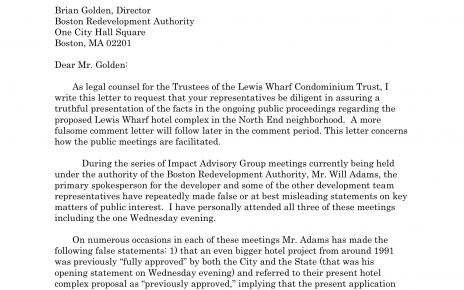
The torrid pace of development and street construction has renewed interest in protecting the historical character of the neighborhood.
On the North End waterfront, efforts for a historic district are moving forward now that City and State officials have issued an official opinion of eligibility for the Old Waterfront Historic District. In documents recently received by NorthEndWaterfront.com, the Boston Landmarks Commission and the Massachusetts Historical Commission agreed during a 2016 review that the district is eligible for “historic” status.
This historic eligibility means that for the purposes of publicly funded projects, properties should be viewed the same as if they were listed on the National Register of Historic Places. The new designation could help preserve notable buildings and elements of the surrounding area. It also can provide property owners with a tax credit to offset restoration and rehabilitation costs.
The Old Waterfront District is comprised of a series of buildings along Commercial Street and Atlantic Avenue on the North End waterfront.
Together, the buildings in the proposed Old Waterfront District represent the phases of transformation that occurred along the North End waterfront from the 1830’s to the 1960’s and beyond. These buildings are associated with the area’s history including its maritime legacy, commerce, industry, transportation and urban renewal.
The southernmost section of the district is the Commercial Wharf area constructed in 1868, subsequently severed into East and West sections.
Adjacent is the Prince Macaroni Factory, 43-63 Atlantic Ave., built in 1917 one of the first renovation and reuse projects in the 1960’s.
Moving northward is the Lewis Wharf granite building, ca. 1832, strongly associated with shipping on the North End waterfront and eventual adaption to mixed use in the 1960’s.
Among the most historic is The Pilot House, opened in 1838 and associated with the Eastern Railroad including ferry service from the North End to East Boston going back to 1854.
Union Wharf, 343 Commercial Street, was constructed in 1846 as a granite warehouse and was listed in the National Register of Historic Places in 1980.
On the northern side of the district is the Lincoln Wharf, 357-371 Commercial St., a rapid transit power station constructed in 1901 and renovated in the 1980’s.
The MHC recommends the historic area also include other Commercial Street buildings: 220 through 254, 336 through 346 and 350.
A historic designation for the “Old Waterfront” would generally requires additional review for project changes funded by public monies, as if they were listed on the National Register. The designation is Federal in nature, but also trickles down to the State level through the Massachusetts Historical Commission with input from the Boston Landmarks Commission.
The National Register of Historic Places is the official list of the Nation’s historic places worthy of preservation. Authorized by the National Historic Preservation Act of 1966, the National Park Service’s National Register of Historic Places is part of a national program to coordinate and support public and private efforts to identify, evaluate, and protect America’s historic and archeological resources. [Read more on the designation restrictions.]

As seen with the recent removal of the area’s brick sidewalks, however, public officials still have latitude for changes especially those justified by safety or disability standards. [See Waterfront Condo Boards Take Issue With City Hall’s “Community Engagement” on removing Brick Sidewalks]. A case was not specifically brought regarding the sidewalks, but the Massachusetts Historical Commission did review the Connect Historic Boston cycle track project.

Beacon Hill has long had historic district designation, yet it still remains in a contentious legal fight regarding the type of brick sidewalk ramps where historic preservation is clashing with perceived accessibility. Other historic districts in Boston exist in the South End, Bay Village and the Back Bay.
Perhaps more relevant to a historic designation would be the impact of redevelopment projects that receive public funding in the “Old Waterfront District.” Unrelated to the historic district designation, State officials issued a setback to the proposed Lewis Wharf hotel when it reduced the project area extending into the harbor.
With the new eligibility in place, future changes to Lewis Wharf or other developments in the area could include a preservation impact review under historic district guidelines.








Matt, I think the brick warehouse buildings, one of which I own, on Fulton and Commercial Sts. are already on the National Register of Historic Places. When we renovated these buildings back in the early 70’s we were told they were registered and we had to follow specific guidelines especially regarding the exteriors of the buildings. We also received tax benefits because the buildings were registered as historic.
I would love it if the entire North End was designated as an historic tenement neighborhood. Already in the Lower East Side of New York real estate developers are buying old tenement buildings , razing them and building fancy townhouses that sell for several million dollars. It would be a shame to see that happen in the North End.
Yes Nick, there are several buildings in and around the North End that are already listed on the National Register. The difference with this is that it encompasses a “district” of properties labeled as the Old Waterfront. As you probably know, there have been similar efforts in the North End for historical district status, but as far as I know, that has not happened. Also note that the designation does not stop private redevelopment and technically only applies when public funds are used.
Our last major effort to designate the entire North End as a historic district occurred in the mid-1980s. Instead we were successful in establishing the 55′ height restriction and roof-top oveylay zoning ordinances. I still have all the documents.